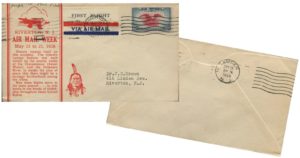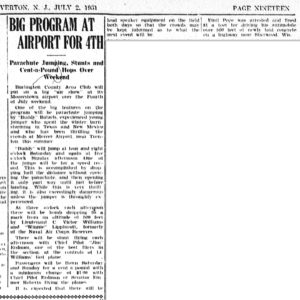
A BRIEF HISTORY OF MOORESTOWN AIRPORT
by
Harlan Radford, Jr.
After nearly fifty years since its closure, information about Moorestown’s nearly forgotten airport is sketchy at best. We are indebted to Paul Freeman for allowing the use of information and images from his informative website entitled “Abandoned & Little-Known Airfields” in developing the following story.
It all started in 1928 when some South Jersey aviation enthusiasts created an organization known as the Burlington County Aero Club. Just one year prior, Charles Lindbergh’s historic solo non-stop crossing of the Atlantic Ocean had captured the heart of the nation. Americans gained new confidence in air travel and suddenly, everybody wanted to fly.
Across the United States that enthusiasm fostered the creation and formation of something called flying clubs, or “aero clubs.” Such private member-run aero clubs were generally not-for-profit. The clubs offered their members affordable access to aircraft and often provided flight training opportunities along with many related services and facilities that enabled aviation enthusiasts to pursue flying as a hobby.

In February 1928, the newly formed Burlington County Aero Club acquired the use of a fifty-acre rectangular tract of farmland from the Lippincott family on Westfield Road. That year the club also purchased two new Waco Model 10 biplanes. This particular airplane was for general aviation and was excellent for training purposes. A popular 3-seater with open-air cockpit, the Waco 10 was a fixed-wing aircraft with two main wings stacked one above the other.
The Burlington County Aero Club constructed a large steel hangar on the north side of the newly secured land and employed a full-time chief pilot and an instructor.


During the weekend of October 13-14, 1928, the Burlington County Aero Club held a special “Air Meet and Races.” On this occasion, the Moorestown Airport was officially dedicated, and to commemorate this event, the club created (as described in The American Air Mail Society/American Air Mail Catalogue – Volume One, Sixth Edition, 1998) a special magenta-inked cachet and processed some 2,000 airmail envelopes postmarked on each of these dates at the Moorestown post office. Most notably, Moorestown’s Airport was the second oldest airport in all of New Jersey; Newark’s Aviation Field became the first in 1918.

According to local press reports, the Moorestown Airport in 1931 was actually being considered to be a base for the German Zeppelin transoceanic mail route. Lakehurst Naval Air Station, also located in South Jersey, finally won out and was selected for the prestigious but short-lived Zeppelin mail route. We all know that on May 7, 1937, the Hindenburg (LZ-129) would burst into flames during a landing at Lakehurst and thus end for that time the promise of a global airship passenger, freight and mail service.
The early years of this country’s Great Depression took its toll on the Moorestown Airport and one source states the airport went through a period of abandonment between 1932-35 and even the 1937 Airports Directory did not list it among active airfields.
The first and probably only “official” Air Mail flight in the history of Moorestown occurred on May 19, 1938, in conjunction with the Post Office Department’s celebration of National Air Mail Week conducted all across America between May 15-21. Proclaimed as a week-long event to commemorate the 20th anniversary of the inauguration of airmail service, Postmaster General James A. Farley and President Franklin Roosevelt promoted and implemented an opportunity to gain wider support and usage of the Post Office Department’s airmail service.
Postal officials encouraged many cities and towns to create their own means to conduct aviation-related activities during that time by promoting and actively participating in special events. For example, 24-hour airmail duty by volunteer pilots all across the nation allowed many communities like Moorestown to get one-day of airmail service.

Riverton Postmaster Mrs. Mervil E. Haas had a commemorative National Air Mail Week (NAMW) 1938 cover with a special cachet prepared for the occasion. Palmyra also sponsored a special cover for the event. On May 19, 1938, East Riverton’s Joseph W. Stow donated his services to pilot the aircraft that carried airmail from Palmyra, Riverton, and Cinnaminson post offices out of Moorestown Airport to Camden’s Central Airport. The cargo that day included the envelope at left bearing the new airmail stamp. Canceled at Riverton and backstamped at Camden, it is addressed to Dr. J.E. Brown at 416 Linden.

This novel idea proved immensely popular. Trumpeting the slogan, “Receive To-morrow’s mail today,” the Postmaster General even requested every American to send an airmail letter during that week. Shown at right is a photo of Postmaster General James Farley sitting with some of the hundreds of thousands of airmail letters mailed during National Air Mail Week.

By the end of the Depression at the close of the 1930s, the Moorestown airfield had become a pumpkin field. However, a 1940 aerial photo and later a 1942 USGS topographic map shows Moorestown Airport open and operational with three runways. Note in the illustration at left the configuration and the lengths of the three unpaved runways along with the airport hangars, buildings, and the obvious wind-cone, or sock, for determining wind direction.
During the years of World War II, eyewitness accounts recorded the presence of military aircraft occasionally using Moorestown Airport. Unfortunately not much else is known about the role of the airport at that critical time.
After the war, two enterprising individuals ran what they called the “GI Bill of Rights Flying School” at the airport and by the mid-1950s the airport saw much greater use. Facilities expanded to include an additional hangar; one hangar sported a painted checkerboard-roof design and the other roof proclaimed “MOORESTOWN.”

By 1958, the airstrip saw the installation of the first landing lights which
enabled planes to take-off and land at night.
As the decade of the 1960s arrived, the encroachment of residential development and the completion and opening in 1965 of the new Moorestown High School that bordered on airport property jeopardized the future of Moorestown Airport. The location of the high school necessitated the closing down of the northeast/southwest runway leaving just two active runways.

In addition, this photograph taken in 2016 shows the houses that have been built over the eastern portion of the former airport site while the western portion which is wetlands remained undeveloped. In the upper-middle portion of this image, note the two still-visible structures including the original circa 1928 hangar along Westfield Road.
The eventual closure of the Moorestown Airport would occur sometime between 1972-73 and with it came to the end of an interesting chapter in the history of the community of Moorestown, New Jersey.
A timeline of Moorestown Airport newspaper articles 1928-1972
We welcome your comments and especially hope that this article may serve to invite some first-hand recollections by former pilots, employees, passengers, or spectators who can add their voices to this online history of Moorestown Airport.
















When I was a kid I lived across the street from the Moorestown airport. The woman who operated the diner on the airport was named Josey. Used to ride our bikes there during the summer for a free soda. Nice woman that gave me my first job, cutting her back lawn for 5 bucks.
The runway was a grass strip and there were power lines at the end of the runway parallel to Westfield rd. Pilots needed to perform short takeoffs to clear the lines. I seem to recall a few take-offs that went bad and the planes had to land in Flying Feather farms fields